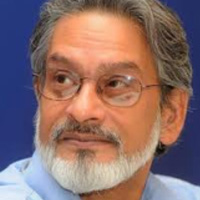As India emerges from the Covid-19 pandemic, economists will have to rethink how they understand the Indian economy in context of global volatilities. In this panel, moderated by Amartya Lahiri, Viral Acharya, Yamini Aiyar and Pronab Sen discuss both the macroeconomic implications of growth, infrastructure and public policy, and the microeconomic concerns of whether we are creating enough good jobs, ensuring welfare, and reducing income inequality.
They begin with a discussion about growth rates and inflation, and Amartya Lahiri notes the recent uptick in household indebtedness. Viral Acharya adds that the capital expenditure cycle is not reflecting in credit growth yet, and there is a concern about household net worth being precarious as real wages have stagnated. This correlates to a retrenchment of domestic consumption, which is increasingly lopsided. He disagrees with Pronab Sen’s view that inflation is optimal at this point, and believes inflation concerns, combined with import-heavy consumption of the wealthy in India affect the country’s current account deficit and external sector national accounting.
This segues into a conversation about inequality, with Yamini Aiyar pointing out that it is unfortunate that there is no publicly available data to answer this question accurately. She emphasises that it is imperative for the community of development practitioners and researchers to demand that India’s statistical system be made robust, since, as Pronab Sen adds, we currently rely on consumption and expenditure surveys that are based on the framework of the 2001 Census. The economic shock caused by Covid-19 came against the backdrop of a slowing economy, and the significant shocks of demonetisation and the introduction of GST on the informal sector. She concludes that health shocks to households during Covid-19; increased shift of enrolment of children from private to public schools; and data points of the PLFS, CMIE data and FMCG sales’ volume growth certainly indicate distress, and that income inequality has risen.
Before going back to questions around health and education, Pronab Sen weighs in on the movement of workers back into the agricultural sector in the last five years, after a sequential decline for over 30 years. This has implications for food inflation, productivity of the economy, and the reversal of the trend of feminisation of the agriculture workforce. Viral Acharya contends that there should be a pathway for rural youth to join the IT sector, which is seeing wage inflation due to a growing demand for these services. To move youth to productive service jobs there should be a focus on investments in skilling and education to leverage India’s success in building the plumbing for a digital economy. The movement of workers back to rural areas could have coincided with the collapse of the real estate markets around 2016, and it’s possible that building the demand for construction and manufacturing jobs can pull people back into urban areas again.
The discussion then moves back to the breakdown of education and health infrastructure during the pandemic. Drawing on personal experience, Yamini Aiyar talks about changes in school management and pedagogy as a response to the pandemic – such as increased parental engagement and a focus on remedial education rather than syllabus completion – as an opportunity to make these standard practices even post-Covid. Similarly, the Indian public health system has historically dealt well with smaller epidemics like the Zika and Nipa virus outbreaks. Building on this experience, policymakers should have maintained trust and invested in frontline workers and the health system to tackle Covid-19, rather than shutting down the economy.
Circling back to the question of infrastructure and building a modern economy which delivers, Viral Acharya sees a scope for scaling back and rationalising subsidies which aim to publicly provide private goods as they become more efficient, even though welfarism has become more attractive. Pronab Sen notes that it takes time to see returns from mega infrastructure projects like highways, ports and airports; although these can’t be run or managed by small and medium enterprises, employment effects will still persist because these are sub-contracted to smaller construction companies. As for the financing of this infrastructure, Amartya Lahiri notes that a few conglomerates are building it using public sector funds from LIC and state banks. Viral Acharya’s concern about a few big private players building public infrastructure – the ‘National Champion’ model – is that capital-allocating institutions may not correctly estimate project viability as they perceive them to be too big to fail. Yamini Aiyar makes a case for investing in infrastructure in small towns – and not only heavily mechanised big-ticket capital expenditure – which will be more employment-intensive, enable the transition to non-farm jobs, and improve rural standards of living.
The panel concludes with a brief consideration of the regulatory and economic costs of climate transition, including the inflationary effects of fossil fuel shocks, and loss of productivity due to extreme weather. They touch upon the importance of taking the environment into account when deciding where infrastructure and manufacturing units should be located, before taking questions from the audience about the agricultural reversal, female labour force participation in the absence of non-rural employment, and the need for skilling and investments in health and education.




 10 February, 2023
10 February, 2023 








Comments will be held for moderation. Your contact information will not be made public.